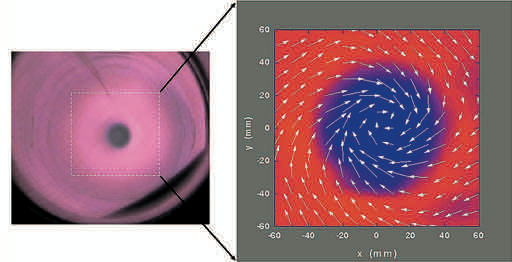プラズマ実験
プラズマ実験
大型の核融合実験装置を用いた燃焼条件に近い高温プラズマや、小型装置による基礎プラズマの実験的研究指導を行います。
大型ヘリカル装置(LHD:Large Helical Device)
 |
核融合科学研究所の中心的なプラズマ閉じ込め実験装置です。2本1組の超伝導ヘリカルコイル(紫色の部分)と、6本3組の超伝導ポロイダルコイル(黄色の部分)により最大約3テスラの閉じ込め磁場を生成し、ドーナツ状のプラズマ(薄紫色の部分)を閉じ込めています。プラズマの大半径は3.5~4.1 m、小半径は約0.6 mです。ヘリカル型のプラズマ閉じ込め実験装置としては、世界最大の大きさです。プラズマは中性粒子ビーム入射(NBI:Neutral Beam Injection)加熱、電子サイクロトロン共鳴加熱(ECRH:Electron Cyclotron Resonance Heating)、イオンサイクロトロン周波数帯(ICRF:Ion Cyclotron Range of Frequencies)加熱などによって最大約1億度にまで加熱されます。燃料の水素は、固定ペレット入射法とガスパフ法の2種類によって供給されます。また多くの計測装置も装備されてます。 |
プラズマ物理・制御
磁場閉じ込め方式での核融合炉実現のためには、高温(~1億度)・高密度(~1020 m-3)・長いエネルギー閉じ込め時間(~1秒)のプラズマを生成し、維持することが必要です。ここでは、このような炉心プラズマを制御する基本要素(磁場配位、壁条件、排気、燃料注入)に関する研究を行います。すなわち、プラズマの平衡・安定性、輸送過程、熱・粒子バランス等の物理機構の解明と、それに基づいた核融合炉心プラズマ生成、温度・密度・不純物の制御、磁場構造やプラズマ粒子の注入・排出、壁材料との相互作用等を含めた炉心プラズマの総合的制御システムとしての観点から教育研究を行います。
(a)高密度・高温プラズマの生成
ヘリカル系閉じ込めで実現される無電流プラズマは電流駆動を必要とせず、高密度に起因する破壊的不安定性(ディスラプション)がないため、トカマクと比べて高密度運転に優れています。高密度運転はプラズマ対向壁損耗を軽減するなど、核融合炉の工学的要求の解決を容易とするとともに、ヘリカル系に特有な新古典拡散の制約を軽減することができます。したがって、ヘリカル型核融合炉の高密度運転シナリオの確立に向けた、無電流高密度プラズマの高性能化は重要な課題です。
LHDの最近の実験により、高効率の排気と中心燃料供給によって、内部拡散障壁が形成され、1021 m-3を超える超高密度プラズマが得られました。この成果は高密度核融合炉心運転に新しいシナリオを提供するものです。一方、この内部拡散障壁形成の物理機構、その炉条件への適用性、超高密度プラズマの運転限界などについての課題が解決すべき事項として具体化してきています。
また、高いイオン温度を実現することは、核融合を実現する上で必要不可欠です。LHDではこれまでに9400万度の中心イオン温度を得ることが出来ました。さらに、このような高いイオン温度が実現している時には、プラズマの回転速度が空間的に大きく変化していることが観測されており、イオンのエネルギー閉じ込めとの関連が調べられています。また、中心イオン温度が高くなると中心での不純物炭素の量が減るという不純物の輸送に関する興味ある現象も観測されました。

(b)平衡配位・磁気流体力学的不安定性の研究
核融合プラズマは、磁力線でつくられたカゴ(平衡配位)によって閉じ込められます。平衡配位は、プラズマの閉じ込め性能および磁気流体力学(MHD:Magneto Hydro Dynamics)特性とお互いに関連しています。高いプラズマ閉じ込め性能や良好なMHD特性を持つプラズマを得るためには、最適な平衡配位を維持することが要求されます。さらに、より高いベータ値(β値:プラズマ圧力と磁気圧力との比)を得るための最適な平衡配位の探求が進められています。LHDでは磁気軸位置やプラズマ半径等、平衡配位の最適化を計って年々最大β値を更新してきており、最近では、5%の目標値を達成するに至りました。高温・高密度のプラズマでは、自らが磁場を横切って逃げる不安定性を起こすことが知られています。β値が3%を超えるあたりからMHD不安定性が観測されていますが、閉じ込めへの影響はほとんどなく、β値は上昇を続け、破壊的な不安定性なしに閉じ込め時間の50倍程度の長時間にわたり安定な高β値を保持することができました。理論研究では、平衡配位の詳細な計算がなされており、実験結果との比較を通じて詳細に研究されています。
 プラズマ圧力によって変形する磁場配位形状
プラズマ圧力によって変形する磁場配位形状 (c)対向壁材料・プラズマと壁との相互作用・ダイバータの研究
核融合研究の歴史上、閉じ込め改善は全てプラズマ対向壁の状態改善やダイバータ磁場配位の採用など、周辺プラズマ制御の進歩によって得られています。また核融合炉実現上の最難関課題の一つは炉壁だと言われています。核融合炉では、炉心プラズマから周辺に膨大な熱・粒子の流出が予想されますので、高性能な炉心プラズマを維持しつつ熱・粒子流を制御してプラズマ対向壁・ダイバータ板の損耗・損傷を防ぎ、かつヘリウム灰除去や燃料供給などの粒子制御をしなければなりません。したがって周辺プラズマやプラズマ・壁相互作用は大変重要な研究課題です。
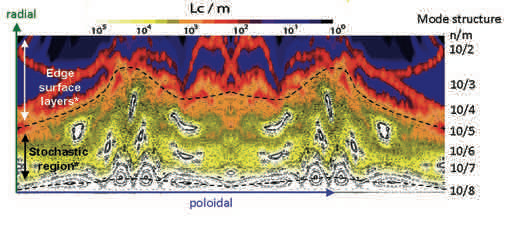 プラズマ領域での磁力線接続長の分布
プラズマ領域での磁力線接続長の分布プラズマ対向壁への熱・粒子負荷の軽減のためには周辺プラズマ中における熱・粒子輸送過程の理解が必須です。また、プラズマ対向壁の損耗・損傷、不純物の発生と輸送、燃料粒子のリサイクリング等はプラズマ制御および対向壁の健全性確保のための重要課題です。プラズマ・壁相互作用に関する研究としては、放電洗浄やコーティングによる壁コンディショニング法の評価および第一壁・ダイバータ板の損耗、再堆積過程の理解とその制御等が挙げられます。これらは、核融合炉を想定した場合の長時間放電の際に特に問題となる課題であり、磁場閉じ込め核融合装置共通の課題です。その解決を通じて、国際熱核融合実験炉ITERを含む次期核融合装置の設計や運転計画立案に寄与しています。
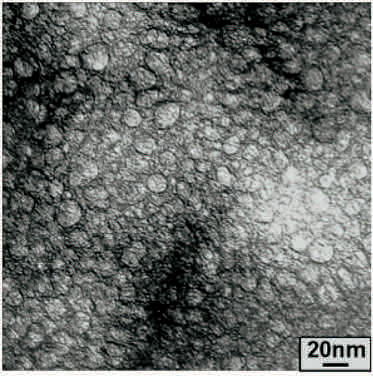
透過型電子顕微鏡で撮影したプラズマ対抗壁(ステンレス鋼)内部に形成された高密度ガスバブル
(d)プラズマの制御に関する研究
超高密度コアプラズマの実現と長時間維持可能な閉じ込め改善運転のためには、磁場配位・密度・加熱などの制御が必要となります。
磁場配位制御の一環として、MHD不安定性の回避をしつつプラズマの高ベータ化を目指すことを目的として、放電時間中に磁場配位を実時間で変化させる実験が開始されました。将来の高ベータ化へ向けた新しい知見が得られる可能性を持った研究が進められています。また、密度制御の手法である燃料供給法には、大きく分けて次の2種類があります。1つは常温の水素ガスを吹き込む方法(ガスパフ)、もう一つは低温の固体水素の塊を高速で打ち込む方法(ペレット入射)です。LHDでは、微小流量から大流量(0.01~240 Pa m3/sec)までの様々なガスパフをプレプログラム制御あるいは密度フィードバック制御で使用できるほか、高速水素ペレット入射装置や連続水素ペレット入射装置など多彩な燃料供給装置が装備されています。
これらの燃料供給法を効率よく運用することで、粒子輸送の研究に資するほか、超高密度プラズマや高ベータプラズマの生成などに貢献しています。
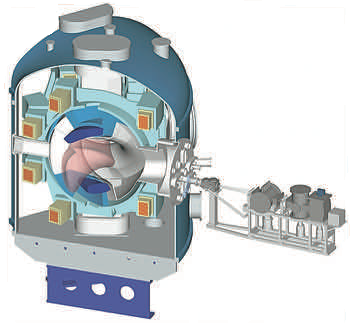 LHDのペレット入射装置
LHDのペレット入射装置
プラズマ加熱
高温高密度プラズマの生成・加熱について、プラズマ物理および装置工学の両面から研究します。プラズマ物理として、プラズマ生成・加熱ならびに電流駆動の機構、大電力加熱・電流駆動の閉じ込め性能への影響について、また同時に装置工学として、高効率プラズマ加熱のための中性粒子ビーム生成方法、電磁波の発生・伝送・入射方法等の最適化の研究ならびに、これらの加熱装置の開発に向けた、大型イオン源、大電力粒子ビーム輸送技術等の開発、大電力高周波源、伝送系要素部品、高性能アンテナ等の設計・開発の研究を行います。
代表的なプラズマ加熱の方法には、高速の中性水素原子ビームをプラズマに入射させて、そのエネルギーでプラズマ中のイオン及び電子を加熱する中性粒子ビーム入射(NBI)、高周波の電磁波をプラズマに入射させて、プラズマ中のイオンまたは電子を選択的に共鳴加熱させる高周波加熱があります。後者には、電子のサイクロトロン運動に共鳴させて加熱する電子サイクロトロン共鳴加熱(ECRH)、イオンのサイクロトロン運動を利用して加熱するイオンサイクロトロン周波数帯ICRF)加熱などがあります。これらの加熱法により、高温プラズマの生成・加熱をはじめとして、プラズマ中に電流を駆動することも行います。
![]()
(a)中性粒子ビーム入射(NBI)加熱
NBIでは、高速の中性粒子をプラズマに入射させて加熱します。高速の粒子ビームは、イオンを電気的に高エネルギーまで加速すれば生成することができますが、プラズマは磁場により閉じ込められているため、外部から荷電粒子を入射させることができません。そこでイオンビームを電気的に中性化してから、プラズマに入射させます。入射した中性ビームは、プラズマとの衝突により再びイオン化されて、磁場に捕捉され、プラズマを加熱します。イオンビームの中性化には水素ガスを用いますが、中性化効率により、核子当たり100 keV以上の高エネルギー領域では負イオンを、それ以下の低エネルギー領域では正イオンを用います。
NBIは大型ヘリカル装置(LHD)における主加熱装置です。負イオンNBIが3台、正イオンNBIが2台の5台が取り付けられており、入射加熱電力の総計は27 MWです。NBI加熱によりこれまでに、1.6 MJのプラズマ蓄積エネルギー、5%を超えるベータ値、9400万度のイオン温度、1.2×1021 m-3のプラズマ密度等を達成しています。
- NBI加熱プラズマのプラズマ閉じ込め特性と輸送の解明
- NBI加熱により達成された高イオン温度プラズマの特性についての研究
- NBI高エネルギーイオンの閉じ込めと損失機構の解明
- NBI高エネルギーイオンが励起するMHDモードとその相互作用の研究
- 入射高エネルギーイオンのプラズマ中での減衰過程の解明

- 負イオン源プラズマの分光的測定
- 負イオンの生成機構とプラズマからの引き出し機構の解明
- ITER-NBIシステムへ向けた高周波負イオン源の開発
- 高エネルギーイオンの中性化に関する研究
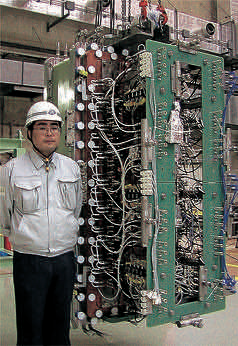
(b)電子サイクロトロン共鳴加熱(ECRH)
ECRHはミリ波を用いてプラズマ中の電子を加熱する手法です。ジャイロトロン装置と呼ばれる発振器によって生成されたミリ波は100 m程度の伝送路を通り、最終的にLHD内部に設置されたアンテナからプラズマに入射されます。
LHDでは1 MWを超えるミリ波出力が可能なジャイロトロン装置が5台あり、最大5.6 MWのミリ波電力をプラズマに入射することができます。ミリ波はアンテナの角度を制御することによって、プラズマの様々な位置に入射することができるため、加熱だけではなくプラズマ中の電場や閉じ込め磁場の制御にも使用されます。
これまでに、ミリ波をプラズマ中心領域に精度良く入射することにより、電子の熱閉じ込め改善を実現し、2億度を超える電子温度を達成しています。また、ECRHによって1時間を超えるプラズマの定常保持も実現しています。
- ECRHプラズマの閉じ込め特性
- 電子内部輸送障壁の形成機構
- ミリ波電流駆動がプラズマ閉じ込めに及ぼす影響
- 電子バーンシュタイン波を用いたプラズマ加熱
- ECRHで生成される高エネルギー電子の振る舞い
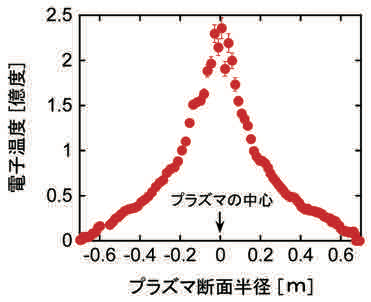
- ジャイロトロンの大電力化
- ミリ波伝送システムの高効率化
- 入射アンテナシステムの高速化・高精度化
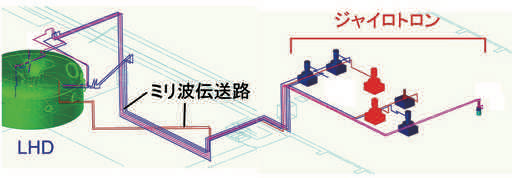
(c)イオンサイクロトロン周波数帯(ICRF)加熱
ICRF加熱では、イオンサイクロトロン周波数またはその近傍の周波数である数十MHzの周波数帯の電磁波を用いて、主にイオンの加熱を行います。サイクロトロン運動をしているイオンを単純に共鳴的に加熱することは、高密度プラズマでは難しいため、プラズマ中に伝搬する波動を介して、二種イオン加熱、高調波加熱等によるイオン加熱を行っています。また、静電波へのモード変換によるイオン・バーンシュタイン波加熱等、電磁波とプラズマの相互作用に関わる研究も行っています。
LHDでは、二種イオン加熱、水素イオンの2次高調波加熱、モード変換による電子加熱、イオン・バーンシュタイン波加熱等の多様な加熱実験に応じた周波数が使われています。高周波源には四極真空管を用いた発振増幅器が4系統あり、同軸管によりLHD本体室へ伝送されます。高周波は整合回路を経て、LHD真空容器内に設けられたアンテナからプラズマへ入射されます。アンテナは3対6本あり、これまでに4.5 MWの加熱電力を達成しています。多様なICRF加熱実験を行っており、加熱モードと加速された高エネルギーイオンの閉じ込めの研究を行っています。また、1時間程度の定常プラズマ加熱と保持を達成しており、その時の加熱入力エネルギーは3.36 GJという世界最高値となっています。
- LHDにおける多様なICRF加熱プラズマの閉じ込め特性の解明
- ICRF加熱により加速された高エネルギーイオンの閉じ込めの研究
- モード変換による電子加熱の研究
- 定常加熱と定常プラズマ保持に関する研究
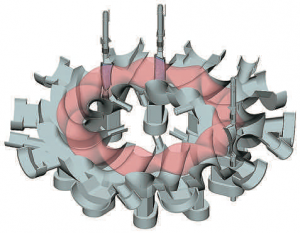
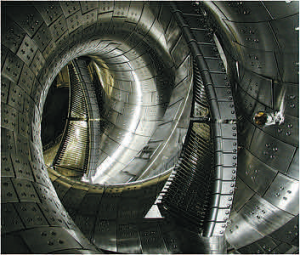
プラズマ計測
プラズマ物理を深く探究し核融合炉を実現するためにはプラズマ特性を正しく計測することが重要です。プラズマ温度、密度、閉じ込め時間の基本パラメータをはじめ、多くの物理量が対象になります。現在、LHDには多くの種類の計測装置が取り付けられています。LHD実験では、これらの計測装置を同時に動かすことによってプラズマの様々な情報を得ることができます。このような多くの情報を総合的に解析することによって核融合プラズマの性能を向上させる道筋が見えてくるのです。
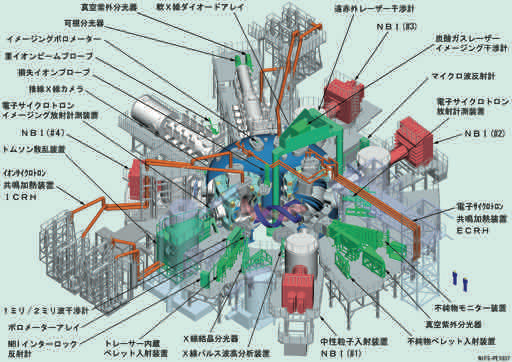
高温プラズマの計測においては静電プローブのようにプラズマに直接計測器を挿入する計測は限られた範囲でしか行うことができません。 したがって高温プラズマ計測は、プラズマから放射される電磁波、粒子などを計測する受動計測、プラズマにレーザー、マイクロ波、粒子ビームなどを入射してプラズマからのリアクションを計測する能動計測の2種類に分類することができます。
- 磁気揺動計測
- 電子サイクロトロン輻射計測
- 高エネルギー粒子計測
- 可視分光計測
- X線計測
- 重イオンビームプローブ計測
- マイクロ波反射計測
- トムソン散乱計測
- 協同トムソン散乱計測
- 遠赤外レーザー干渉計
- ダイバーター干渉計
- 荷電交換分光計測
- トレーサペレット入射による計測
プラズマ計測技術は、常に新しいアイディアや最新のテクノロジーにより発展し続けています。
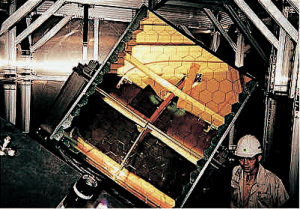
プラズマイオン温度計測
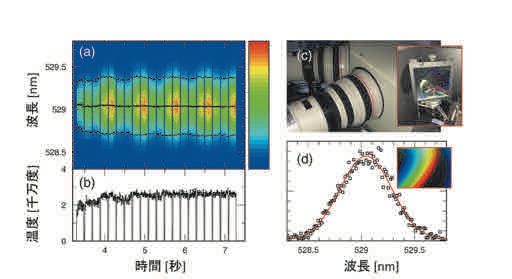
核融合プラズマでは温度計測のため、プラズマから出てくる光の情報を用います。プラズマからは様々なエネルギー(色)を持った光が出てきます。この中から温度の情報を持つ光だけを取り出すため、「分光器」と呼ばれる機器を用いて光をエネルギースペクトルに分解します。取り出した光のスペクトル広がりから、プラズマの温度が計算されます。プラズマ温度計測は、核融合の実現に私達がどれだけ近づいているかを知るために、欠かせない計測器です。
イメージング計測技術
プラズマの外で得られる情報だけでプラズマ内部の様子を知ることは、とても難しいことです。しかし近年のプラズマ計測技術は、この問題を解決し現在ではプラズマ断面の物理量の1次元的な分布を同時に計測できるようになりました。さらに分布が時間によって、どのように変化するのか、ということも測定可能になりました。
最新の計測技術発展の成果は、このような1次元計測から、さらに進んで核融合プラズマの2次元分布を、写真撮影したように同時に計測するイメージング計測が可能になったのはCCDなどの高性能な2次元検出器と大量のデータを瞬時に解析することを可能にした情報処理技術が両輪となって発展したことによります。イメージング計測は、我々に核融合プラスマの複雑な様相を垣間見せてくれます。
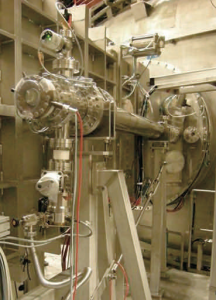
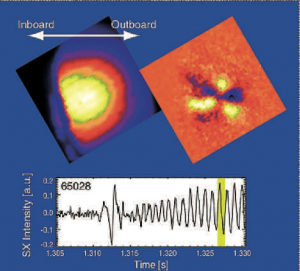
プラズマ計測は現在も発展し続けている研究分野です。まさに未開の荒野を開拓していくチャレンジングな世界であり、新しい発見に出会える興奮が、そこにはあります。また近年、プラズマ技術がナノテクノロジーなどの産業分野に盛んに応用されるようになってきましたが、そのような最前線の舞台でも核融合科学研究所で開発されたプラズマ計測技術が重要な役割をはたすことでしょう。
プラズマ基礎
核融合科学研究所では、LHD実験、数値シミュレーション、炉工学を3本の柱として研究が進められていますが、他にもいくつかの支援装置があり、プラズマ科学分野全般において有用となると考えられる基礎的な研究を全国の大学との共同研究として行っています。
小型装置によるプラズマ基礎実験では、大型装置ではなかなか実行できない、プラズマを直接目で見て、手で触れて実験を進めることができるという魅力があります。将来、核融合プラズマ研究の道へ進むことを希望している方にとっても、学生時代にこのような規模の小回りの効く装置で実験を行うことは非常に有意義な経験になるでしょう。もちろん経験だけでなく、これらの小型装置を用いてプラズマ基礎分野での新しい発見も可能ですし、それを目指して全国の大学の共同研究者との研究が進められています。
HYPER-Ⅰ装置におけるプラズマ基礎実験
HYPER-Ⅰ装置は周波数2.45 GHz、最大出力80 kWのマイクロ波源を用いて、直径30cm、長さ2m、電子密度1019m-3の高密度定常プラズマを生成することができます。磁場配位は弱発散型で、プラズマは電子サイクロトロン共鳴過熱によって生成されますが、このときマイクロ波を右回り円偏波で磁力線に沿って強磁場側から入射することで正常波モードのカットオフ密度を大きく上回る高密度プラズマを得ることができます。
こうして生成されたプラズマは荷電粒子の集合ですから電気的・磁気的な相互作用によって様々な集団運動を形成します。また大規模な流れの空間パターン(渦)を自発的に形成することがあります(図2)。
これらの渦構造の形成機構を理解するには、プラズマの温度、密度、電位分布、速度場等、様々な物理量を計測する必要があります。HYPER-Ⅰ装置ではこれまで各種ブローブを用いた粒子計測を主に行なってきました(図3)。最近ではレーザーを用いた分光学的計測に力を入れ始めています。レーザー計測ではプラズマに対する擾乱が小さく、流速の絶対値が得られるという利点があります。また、中性粒子の計測も可能となるため、これまで電子・イオンといった荷電粒子のみのダイナミックスを考えていた現象に対して、中性粒子の流れとの相互作用といった新しい観点からの研究の進展が期待されています。
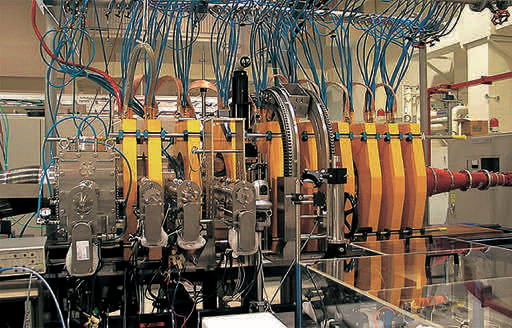

(左)銀河の渦巻きのような”スパイラル渦”
(中)台風の目のような密度ホールを伴った「プラズマホール」
(右)明るく光る渦がEXBドリフトとは逆向きに回転する「反EXB渦」
